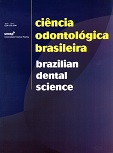Efeito dos tratamentos superficiais para reparo em cerâmica: avaliação por meio da microscopia eletrônica de varredura
DOI:
https://doi.org/10.14295/bds.2006.v9i3.211Abstract
As falhas em Prótese Parcial Fixa podem ocorrer de muitas maneiras, sendo a fratura da porcelana associada ao grupo de problemas mecânicos. Esta ocorrência pode ser reparada sem a necessidade de remoção da peça protética, embora a substituição da restauração seja considerada a solução ideal. Assim, diferentes tratamentos superficiais são utilizados para melhorar a força de união entre cerâmica – resina e viabilizar o reparo. Este estudo analisou a superfície cerâmica tratada com ácido fosfórico à 37% e ácido fluorídrico à 9,5% por meio da microscopia eletrônica de varredura. Quarenta amostras cerâmicas (VITA Zahnfabrik, Alemanha), foram confeccionadas a partir de uma matriz metálica circular, com dimensões de 10mmx3mm. As amostras foram divididas nos seguintes grupos, I) controle – sem tratamento; II) tratamento com ácido fluorídrico à 9,5% por 1 minuto; III) tratamento com ácido fluorídrico à 9,5% por 2 minutos; IV) tratamento com ácido fosfórico à 37% por 1 minuto; V) tratamento com ácido fosfórico à 37% por 2 minutos. Após os respectivos tratamentos, as amostras foram metalizadas (20Kv, 15mA, 2 minutos), no aparelho Denton Vaccum Desk II, sendo em seguida, analisadas no MEV (JEOL – JSM 5410). As superfícies tratadas com ácido fosfórico à 37% por 1 ou 2 minutos não apresentaram alterações morfológicas significativa, enquanto a superfície cerâmica tratada com ácido fluorídrico à 9,5% por 1 minuto já apresentou alteração morfológica significativa, sendo este achado mais evidente após 2 minutos de aplicação. Clinicamente este trabalho sugere um reparo mais eficiente quando a superfície cerâmica é tratada com ácido fluorídrico.
Downloads
Downloads
Published
How to Cite
Issue
Section
License
Brazilian Dental Science uses the Creative Commons (CC-BY 4.0) license, thus preserving the integrity of articles in an open access environment. The journal allows the author to retain publishing rights without restrictions.
=================




























